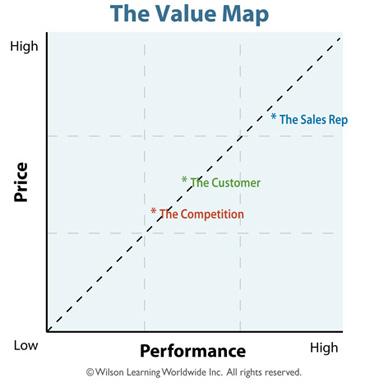Competitive Superiority
Execute Competitive Moves and Countermoves to Win the Business

Salespeople are often told to “sell the value,” but what does that mean?
Precious little—especially when ceaseless technological advances and rapid marketing shifts drive customers to rethink their priorities and what will help them drive their business forward.
Consider the following scenario:
A salesperson had worked with her customer contact for several years, helping him leverage her leading-edge technology to deliver on key business goals. She built a solid working relationship and became her customer’s resource for insights—and relied on her customer for new opportunities.
When the customer put a new project out for bid, the salesperson wasn’t concerned; she was certain that he did so only to satisfy procurement’s requirements. She presented her proposal with anticipation, satisfied that her solution was on target and her pricing was competitive.
A week later, she received a call from her customer. She picked up his call with enthusiastic confidence, sure that he would ask her team to start implementation soon. Instead, he said they’d chosen a vendor that offered “better value.”
The salesperson was stunned. Her customer always told her how much he prized her company’s quality, reliability, and service.
What she didn’t know—but her competitor did—was that the buying committee was led by a finance director, who was concerned about capital expenditures, and the COO, who was concerned about minimizing operational disruptions. When balanced against these overriding interests, the salesperson’s high service levels, while nice, were irrelevant.
In short, she lost because she didn’t understand what the customer organization as a whole valued most.
When has this happened to one of your salespeople?
We say when—not if—because all salespeople get blindsided at least once in their career. That’s hardly surprising. Data shows that when customers tell salespeople they appreciate their work, they mean it. In a study conducted by the Peppers & Rogers Group, 80 percent of customers described themselves as “satisfied” or “very satisfied” with their current vendor—just before they switched to a new one.1
What gives? And—more importantly—how can you make sure this doesn’t happen to your team?
Salespeople Know What Customers Value . . . Don’t They?
Some salespeople rely on information in an RFP to align their offering with the customer’s defined requirements, but the RFP includes only selective chapters of the overall story. To learn the whole story and find out what really matters, salespeople have to acquire the perspectives of multiple stakeholders, not just one or two call points.
Finally, salespeople have gathered the information they need, but they view what they’ve learned through the prism of their own company’s offerings and value proposition. Their view of value is colored by what they think is important, not key stakeholders’ perspectives. Consequently, they tend to present “speeds and feeds”—the technical aspects of their offering—and fail to connect the dots between the customer’s business issues and their solution.
This failure leads to lost sales. In 2017, SiriusDecisions reported that sales leaders’ top challenge was their sales teams’ “inability to communicate value differentiation.”
Getting over this hurdle requires salespeople to understand:
- The customer’s view of value
- How to ensure they are more closely aligned with the customer than their competitors
Identify the Customer’s View of Value

The customer’s view of value has two components: price and performance. When placed on two axes, they form the Value Map.
While every customer would love to achieve game-changing performance with minimal cost, most know that isn’t realistic. Instead, fair value lies in the balance between value and price.
- Customers that want the highest possible performance must pay to get it.
- Customers who can accept lower levels of performance will pay a lower price.
Sometimes a customer falls below the fair value line—they want performance that exceeds a reasonable price. Several factors may be at play:
- They may not have experience purchasing this type of solution, so they don’t know what a reasonable price is—so the salesperson needs to guide them.
- They may not see the full value of the solution—so the salesperson needs to make a stronger connection between the solution and the customer’s highest priorities.
Furthermore, most B2B buying decisions have multiple stakeholders, and they may have varying perspectives about:
- How to define performance
- What they are willing to pay for the solution
These differing views of value can lead to a competitive disadvantage, unless the salesperson creates and deploys an effective competitive strategy.
Lay the Groundwork for a Winning Strategy
Answering three key questions informs the competitive strategy.
1. How does the customer define performance?
Stakeholders may have an array of performance definitions based on their perspective of their business issue and how to solve it. Is their highest priority after-purchase service? Ease of use? Reliability? Salespeople must remain focused on the customer’s view, which can be challenging. It’s easy to think they want the latest technology if that’s what your company is known for—but to do so is a mistake. Any value map is only as solid as the data that goes into it.
2. How does the customer define price?
Customers have different levels of price sensitivity and, like performance, define it differently. Some are concerned about the initial upfront purchase price; others focus on the total cost of ownership. Knowing their view can help the salesperson modify TOCs and payment terms to more closely align with the customer.
3. Where are the customer, you, and the competitor on the Value Map?
Once you understand the customer’s idea of value (price and performance), salespeople can place the customer on the Value Map, and then themselves and their competitors. Doing this as objectively as possible gives a clear picture of who is aligned with the customer and who is not—and helps determine the competitive strategy that will lead to a win.
Compete and Win
If your salesperson and the customer are nearby on the Value Map, go for it! Close the business quickly before competitors can change the playing field.
Unfortunately, this happy circumstance is less common than we would wish, which means salespeople need different strategies for different realities.
If the customer and the salesperson’s solution are at different places on the map, the salesperson can bundle or unbundle their offering and increase or decrease price accordingly. Doing so makes sense, unless a competitor is already close to the customer.
In that case, the competitor will likely try to close the sale quickly, just as your salesperson would if aligned with the customer. So, what’s their alternative?
Assuming the deal is worth the resources needed, the salesperson can work to change the customer’s point of view—about the problem, the approach they’re taking to address it, or the optimal solution. The time and effort required to change the customer’s perspective can definitely be worth it when the revenue and margin are significant or a win offers a beachhead in a new account or division.
Those strategic decisions are up to you and your sales team, based on the understanding of the competitive landscape you get from the Value Map.
Be Ready for Competitors’ Countermoves
No competitive strategy exists in a vacuum. Every move a salesperson makes leads to countermoves from competitors. Make sure your salespeople constantly clarify their understanding of the customer’s view of value and assess how competitors might position themselves.
The Value Map defines the lay of the land and helps salespeople execute the most effective competitive strategy for a given opportunity. It helps salespeople deliver the solutions that customers need—while outmaneuvering the competition.
1 https://www.customerexperienceinsight.com/the-no-1-reason-why-customers-stay-or-leave/
更多信息请洽021-23571788。








 请填写此表格下载Competitive Superiority | Execute Competitive Moves and Countermoves to Win the Business。
请填写此表格下载Competitive Superiority | Execute Competitive Moves and Countermoves to Win the Business。





